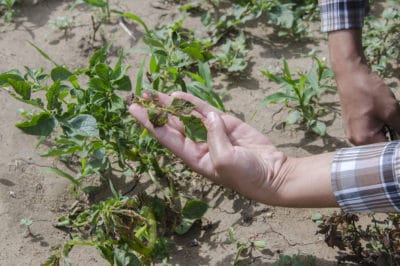Disease Basics
Potato diseases generally fall into three categories – bacterial diseases, fungal diseases and virus diseases. Cool temperatures and wet weather increase the risk of fungal infections. Air circulation, humidity and temperature in storage are all factors that can impede or increase the risk of all potato diseases. Good garden sanitation practices are also critical in decreasing the potential for disease.
Environmental Conditions
The environment is a major player in the development of disease. For example:
- Common scab is less likely if the soil pH is at 5.2 or slightly lower.
- Inadequate oxygenation in storage increases the risk of fungi and may also cause black heart, which rots the potato from the inside.
- Storage conditions with temperatures below 50°F (10°C) and above 90°F (32°C) increase the risk of bacterial soft rot.
- Blight increases in cool, rainy springs.
Fungal Diseases
Potatoes may become infected with a number of fungal diseases. Blights are perhaps the most common and serious. Rusts, rot and mildew are also problems in potatoes. Wet soil, humid conditions and cool weather increase the risk of all fungal problems. It’s important not to over-water potatoes and to make sure the soil drains well. Potatoes should not be washed after harvest; just brush off loose dirt.
Bacterial Diseases
Common scab, caused by Streptomyces scabiei, is the chief bacterial disease to worry about when growing potatoes. The bacteria lives in the soil and is found in nearly all USDA Zones where potatoes are grown. Several rots are caused by bacteria – ring rot, brown rot and soft rot, or blackleg. Using disease-free seed potatoes and avoiding wet soils or fresh manure can help prevent the disease.
Several dozen viral diseases affect potatoes; some also infect other plants. Since viral diseases are often spread by insects, keeping insect populations down may help prevent the disease. Aphids, for example, may spread several viruses. Many potatoes develop immunity to these diseases as they mature. Choose certified disease-free seed potatoes. Control aphids with ladybugs and insecticidal soap sprays.
Other Prevention Strategies
Choose disease resistant varieties when possible. Follow recommended spacing when planting to ensure good air circulation. Sometimes an early harvest can head off problems with blight. Never over-water potatoes – plant on ridges if the soil drains poorly. Cure potatoes properly before storage. Remove and burn infected plants. Practice good garden sanitation – clean up culls, for example. Check potatoes in storage and remove any that are diseased.
